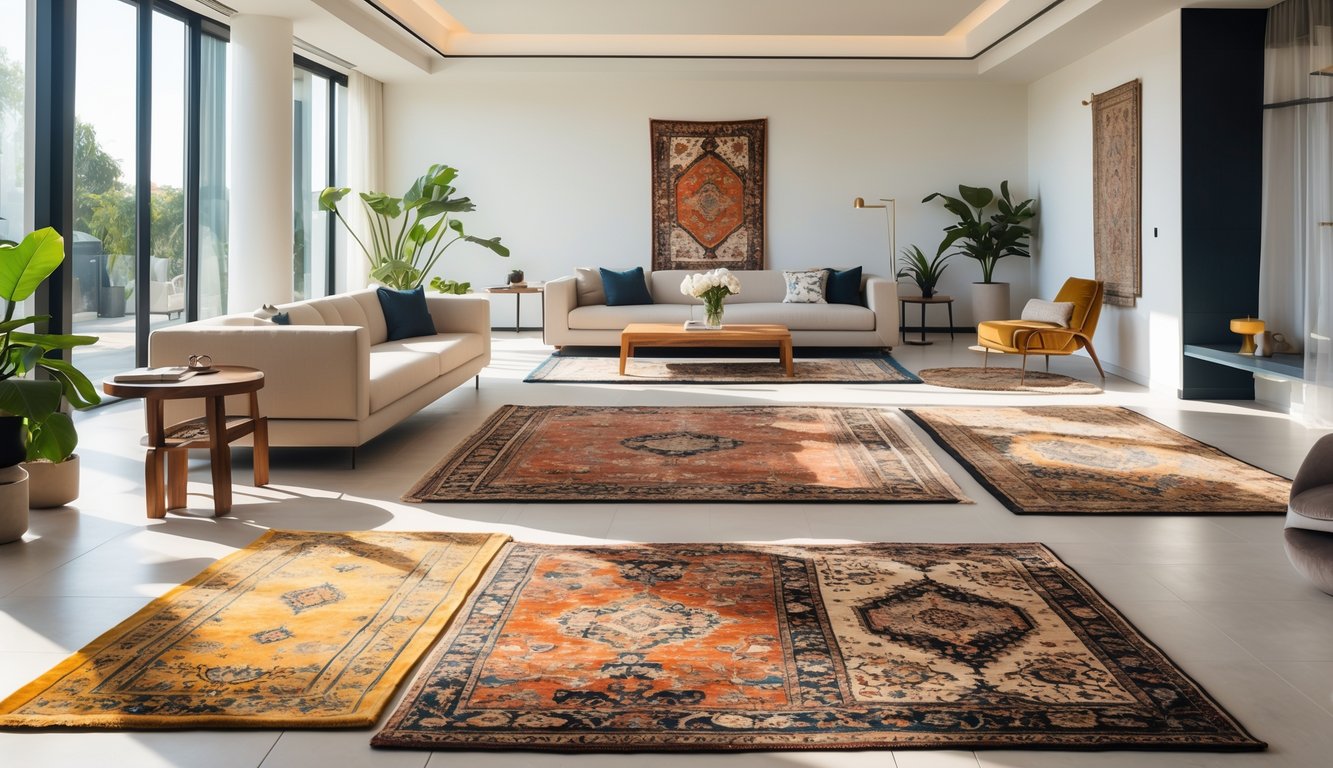
How to Incorporate Investment Rugs into Home Decor
Why do people sleep on the power of a good rug? Stats say luxury rugs can appreciate and outlive your sofa, but nobody seems to care. Layering textures and making a focal point—this isn’t rocket science. Most decorators just pile on textiles and let the rug do the heavy lifting. I mean, it’s not magic, but it works.
Blending Rugs with Existing Textiles
Ever swap out a sad throw for something that actually matches your rug’s colors? I did, and suddenly my bargain-bin curtains didn’t look so tragic next to a deep red silk runner. Some designers go on and on about “material interaction,” but honestly, it’s just noticing that linen and wool sometimes look weird together. I put a wool rug under a linen sofa once—bad move, pilled everywhere and looked thirsty. If you stick with neutral, natural fibers, it all kind of works out. Or that’s what the luxury rug market wants us to believe.
Color matching is a nightmare. Half my samples make the living room look like Halloween, and pattern-mixing? Supposedly it works if you anchor with a solid, but does anyone actually do that? I tossed a blue pillow on a chair to echo my rug’s secondary color, and my decorator friend called it “accidental genius.” Pretty sure she was joking, but I’ll take it.
Creating Visual Impact with Rugs
I give up trying to make small rugs work in big rooms. Anyone who says a 5×7 can “define” a space is lying. Go big. Even minimalists know a huge rug almost touching the walls makes the whole room look bigger. I saw this in a tiny New York apartment—the rug did more work than the windows.
It’s wild how a bold, hand-knotted rug can make boring furniture look intentional. I’ve tried arranging pillows and coffee tables, but the rug always wins. Trade shows push “statement rugs” as art, which sounds ridiculous, but honestly, when I angled my rug to match the traffic flow at home, the whole place just felt right. Collectors and industry folks swear resale value goes up when the rug dominates. Maybe that’s extreme, but hiding a luxury rug feels like buying a Ferrari and never leaving the driveway.
Frequently Asked Questions
Why are rugs so expensive? Every time I look, hand-knotted wool ones cost more than my car, but the stuff I’ve found in “budget” rugs is honestly disturbing. It’s not just branding—texture, weave, the way the pattern fades over time, all that stuff actually matters. Or so I keep telling myself.
What characteristics define a high-quality rug that is worth the investment?
Touch a viscose rug, then touch a real hand-knotted wool one. Trust me, the cheap one loses its shine after a summer in the sun. Good rugs feel heavy and dense—like, a Persian Tabriz is so flat and packed, it’s almost weird. My favorite thing? Sometimes the weaver’s name is in the border. If you can’t tell hand-spun wool from synthetic, maybe let someone else do the shopping.
Which rug brands are known for their long-lasting durability in family homes?
I’ve watched kids and dogs destroy polypropylene rugs—they just shed and fall apart. Stark and Dash & Albert, though, make wool rugs that survive claws and grape juice. It’s always the dog, not the kids, that ruins things. Machine-washable runners? Only some actually last. Some rugs become family, others end up on Craigslist.
Where do interior design experts recommend shopping for premium area rugs?
Designers always say skip the big-box stores and go online, especially for Turkish or Oushak patterns. I get lost in the Edward Fields catalog, but sometimes a tiny local shop has the best Moroccan Beni Ourain rugs—like, straight from the Atlas Mountains, still smells like goat. Flea markets? Only if you want to be disappointed.
What rug options are best for homes with pets while still maintaining a stylish look?
Why is every “pet-friendly” rug scratchy and synthetic? Real answer: flat-weaves (kilims) make pet hair easy to clean, and wool actually sort of cleans itself—at least, that’s what my dog’s endless shedding suggests. Nothing’s perfect, but faded geometric patterns hide stains and muddy paws. Nobody ever mentions flea-market dhurries, but honestly, they’re nearly indestructible.
How do you determine the true value of a high-end rug beyond its brand name?
Sometimes I stare at a designer label and wonder if it’s all marketing. Auction results—like, millions for a Mohtasham Kashan—aren’t helpful when you’re just trying to buy one good rug. Flip it over: check the knots, look for pattern clarity, and if it smells like plastic, run. Sometimes the best rugs are hiding in estate sales, and yes, you actually need an appraisal, no matter how confident your friend is about their “eye for antiques.”
Can you recommend any rug brands that combine both aesthetic appeal and functionality?
I mean, sure, you could go Madeline Weinrib if you’re all about that hand-loomed, “look at me, I have taste” vibe. But honestly, when I’m staring at a coffee stain that’s somehow spread into a Rorschach test, I just want a Ruggable. Yeah, I know, machine-washable Persian-ish prints aren’t exactly museum pieces, but if you’ve got a kitchen or a toddler—who cares? Don’t stare too long; you’ll see the pixels. Dash & Albert? They’re fine. I guess their flat-weaves are weirdly puppy-proof, and the colors don’t scream at you, which is a win if you hate drama. Oh, and here’s the kicker: my favorite rug, the one that actually looks expensive, came from some random market in Uzbekistan. Dirt cheap. Still looks perfect, even after years of me dragging furniture, bags, and, I don’t know, existential dread across it. So why are we paying hundreds again?